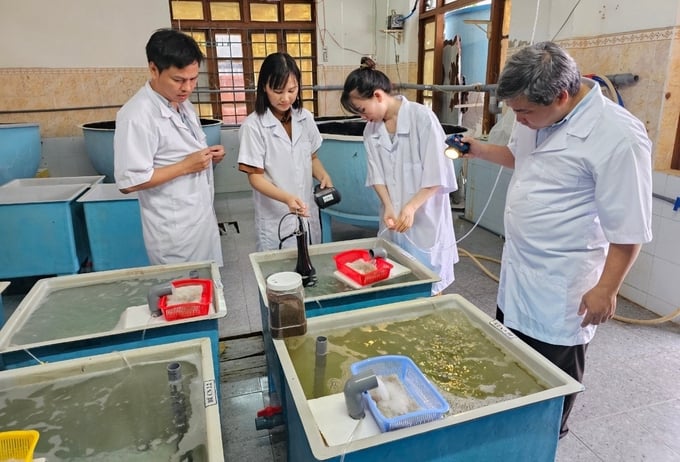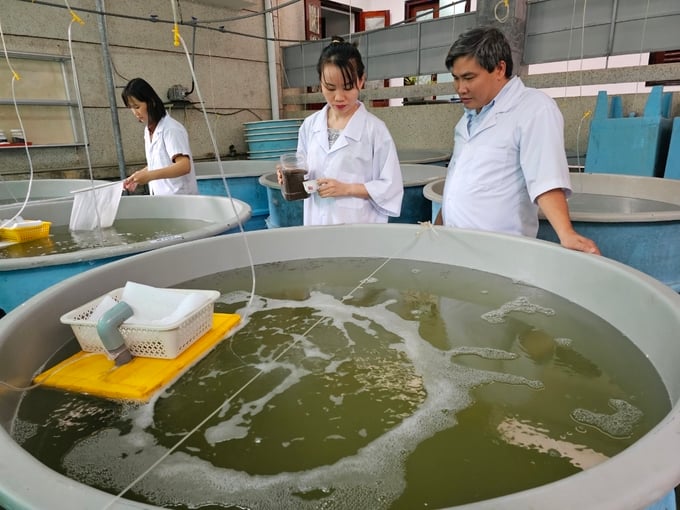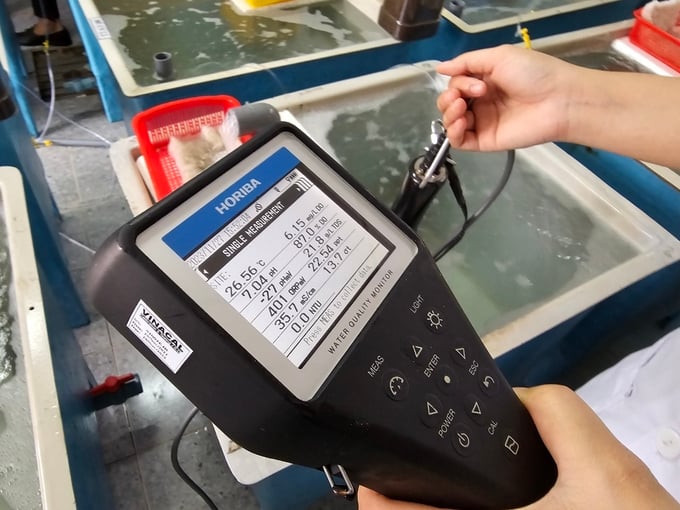June 20, 2025 | 22:51 GMT +7
June 20, 2025 | 22:51 GMT +7
Hotline: 0913.378.918
June 20, 2025 | 22:51 GMT +7
Hotline: 0913.378.918

Scientists from Research Institute for Aquaculture III have conducted a barramundi farming experiment to determine the waste load during the mariculture process. Photo: KS.
It is necessary to determine the waste load in mariculture to promote the development of offshore mariculture. In this regard, the Prime Minister has issued Decision No. 1664/QD-TTg on October 4, 2021, approving the Project on the Development of Mariculture in Vietnam until 2030, with a vision towards 2045. The project sets the goal of developing mariculture into a large-scale, industrial, synchronized, safe, efficient, sustainable, and environmentally friendly commodity production sector, whereby branded products will be manufactured to meet the domestic and export market demands.
With the advantage of long coastlines and numerous bays, provinces in the South Central region have utilized their inherent potential to develop cage mariculture. Main local aquaculture species including various marine fish (barramundi, golden pompano, cobia, etc.) and lobster (spiny lobster, ornate rock lobster, mud spiny lobster), are primarily raised in cages and traditional raft systems.
Offshore mariculture in the South Central region has brought substantial economic benefits to local farmers as well as made a significant contribution to the economic structure of the coastal regions. On the other hand, cage mariculture activities generate a noticeable volume of waste at sea, contributing to the deterioration of the environmental quality in enclosed bays. Despite the observable impact on the marine environment, there is currently limited quantified information available for the volume of waste generated through mariculture activities.

The experimental farming model involves establishing three independent variables, each repeated three times, to identify the sources of both dissolved and non-dissolved waste. Photo: KS.
According to the annual environmental monitoring results in select provinces, including Phu Yen and Khanh Hoa, conducted by the Research Institute for Aquaculture III (Institute III), the sea cage shrimp farming areas in Xuan Dai Bay, Van Phong Bay, and Cam Ranh Bay exhibit periodic monitoring indicators which exceed allowable limits several times throughout the year. These exceeded indicators include ammonia, nitrite, nitrate, phosphate, chemical oxygen demand, coliform density, vibrio, etc., found in both coastal water samples and water from shrimp cage farming areas.
Subsequently, the Ministry of Agriculture and Rural Development assigned Institute III to lead the task of establishing a scientific foundation, and collecting data on pollution sources and waste load from mariculture activities in the South Central region from 2023 to 2025.
Barramundi, which is a type of seabass, play a significant role in global mariculture, especially in Southeast Asian countries. They can thrive in both saltwater and freshwater, are easy to farm, grow rapidly, and boast high nutritional value, making them a focus for industrial-scale mariculture.
Consequently, Institute III is conducting studies on the barramundi, in conjunction with two other economically valuable species, lobster and oysters, to determine the waste load from cage mariculture. Notably, scientists at Institute III conducted a barramundi farming experiment in 2023 to assess the waste load from mariculture activities. The experimental model is implemented in two stages: the seedling stage and the commercial farming stage. Both of the stages are carried out in composite tanks to evaluate the waste load at each stage of production.

The research team monitors environmental factors on a daily basis. Photo: KS.
Master Vo Thi Ngoc Tram, Deputy Director of the Environmental Monitoring and Aquatic Disease Center for the Central Region (a unit under Institute III), and leader of this scientific task, shared that each stage assigned with an independent variable, with each repeated 3 times. These variables include traditional farming using natural feed, industrial farming with commercially available feeds, and a control group with three tanks not containing barramundi.
On a daily basis, the research team monitors basic water environmental factors such as temperature, pH, dissolved oxygen (DO), salinity, among others. Additionally, the team records the discharged waste and excess feed volume to calculate the waste load over specific time intervals.
According to Master Vo Thi Ngoc Tram, the research team takes two main waste sources into account for the calculation of the total waste load from mariculture activities. The two sources include: dissolved waste source, calculated through key indicators such as total nitrogen and total phosphate; non-dissolved organic waste source calculated through key indicators such as excess feed and fish excrement.
"To month, we have conducted the experiment for nearly 2 months, with a high survival rate of the farmed barramundi. We have also extracted sufficient data to begin evaluating the waste load from barramundi farming under experimental conditions," shared Master Vo Thi Ngoc Tram.
Assoc. Prof. Dr. Vo Van Nha, Deputy Director of Institute III, stated that the assessment of waste sources and waste load in mariculture is a necessary and crucial solution to determine a suitable stocking density and avoid overloading the mariculture environment. This task has been assigned to Institute III by the Ministry of Agriculture and Rural Development in 2023.
According to Assoc. Prof. Dr. Vo Van Nha, the research team has been tasked with assessing the state of waste generation from mariculture activities, identify waste sources and waste load in mariculture with different species. Subsequently, the team will propose suitable technical and management solutions to develop sustainable mariculture.
"The technical and management solutions to reduce waste load from mariculture activities also contribute to the sustainable development of Vietnam's mariculture as a whole," emphasized Assoc. Prof. Dr. Vo Van Nha.
According to Assoc. Prof. Dr. Vo Van Nha, the research team at Institute III conducted an assessment towards the end of 2023 on waste sources and waste load from the experimental barramundi farming activities, utilizing different types of feed corresponding to traditional and current industrial farming practices. This assessment allows the team to calculate the load of non-dissolved organic waste and dissolved waste during the farming process. Consequently, results of the assessment will serve as a basis for the research team to calculate the waste load for the current cage mariculture system and, in conjunction with other studies, assess the waste capacity of a specific marine area.
Translated by Nguyen Hai Long
![Turning wind and rain into action: [9] Digitizing hydrometeorological data in response to climate change](https://t.ex-cdn.com/nongnghiepmoitruong.vn/608w/files/news/2025/06/17/z6704423696987_15fd32ffc26d590d204d520c9dac6786-nongnghiep-165943.jpg)
(VAN) Farmers have begun accessing hydrometeorological applications to adjust their cropping schedules, aiming to ensure productivity and adapt to climate change.
![Turning wind and rain into action: [8] Real-time salinity detection and early warning technology](https://t.ex-cdn.com/nongnghiepmoitruong.vn/608w/files/news/2025/06/17/z6704423696987_15fd32ffc26d590d204d520c9dac6786-nongnghiep-151127.jpg)
(VAN) Thanks to the integration of modern hydrological-hydraulic models, remote sensing technologies, and artificial intelligence, the accuracy of hydrological forecasting has significantly improved.
![Turning wind and rain into action: [7] Early disaster warnings help marine farmers minimize losses](https://t.ex-cdn.com/nongnghiepmoitruong.vn/608w/files/news/2025/06/17/z6704423696987_15fd32ffc26d590d204d520c9dac6786-nongnghiep-142942.jpg)
(VAN) In recent years, thanks to early disaster warnings and forecasting, marine farmers in Khanh Hoa province have been able to reduce risks and losses, thereby improving production efficiency.
![Turning wind and rain into action: [6] ‘Four on-the-spot’ disaster management software](https://t.ex-cdn.com/nongnghiepmoitruong.vn/608w/files/news/2025/06/17/e5a48259d6a262fc3bb3-nongnghiep-183800.jpg)
(VAN) By simply activating the scenario on the disaster management software, the relevant authorities immediately know how many households need to be evacuated, where to evacuate them to, and by what means of transportation…
![Turning wind and rain into action: [5] Hue applies modern technology in disaster forecasting](https://t.ex-cdn.com/nongnghiepmoitruong.vn/608w/files/news/2025/06/17/z6704423696987_15fd32ffc26d590d204d520c9dac6786-nongnghiep-093938.jpg)
(VAN) In Hue city, modern technology has recently been applied in meteorological and hydrological forecasting and warning, helping to reduce the damage caused by natural disasters.

(VAN) A cutting-edge farming technique being implemented on an experimental ranch in Arizona's Sonoran Desert has already saved a billion gallons of water over five years, according to Civil Eats.

(VAN) Poultry and pig production and the environment can be boosted through enhanced water technology, according to new research.